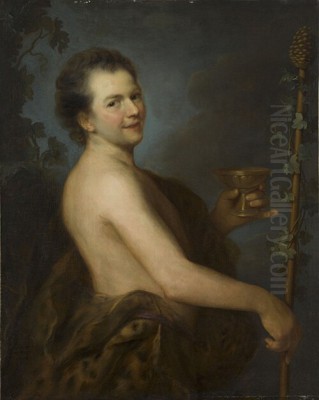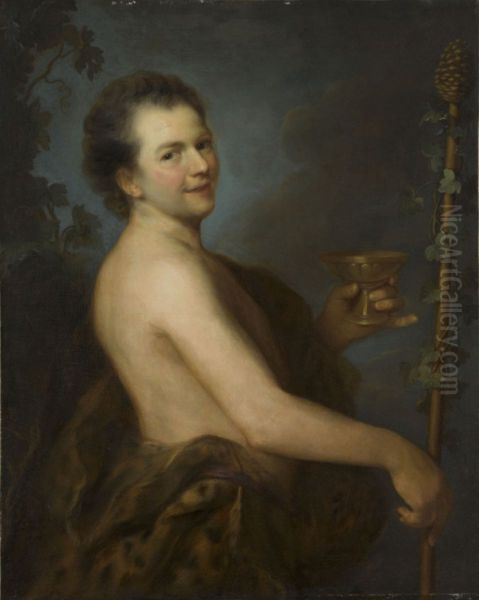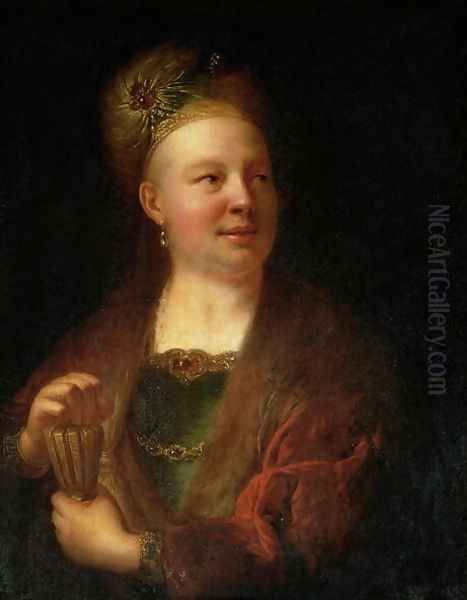
Alexis Grimou stands as a fascinating yet somewhat elusive figure in the landscape of early 18th-century French art. Born in Argenteuil on May 24, 1678, and passing away in Paris in 1733, Grimou carved a unique niche for himself, primarily as a portraitist whose style earned him the evocative nickname "the French Rembrandt." His work bridges the gap between the established traditions of Northern European painting and the evolving tastes of Parisian society during the Régence and the early years of Louis XV's reign. Despite facing professional hurdles and cultivating a reputation for a somewhat bohemian lifestyle, Grimou's artistic contributions, particularly his intimate character studies and skillful manipulation of light, left a discernible mark on French painting.
An Unconventional Path to Artistry
Unlike many of his contemporaries who followed the rigorous, structured path of the Académie Royale de Peinture et de Sculpture, Alexis Grimou's artistic education was largely unconventional. He did not emerge from a traditional apprenticeship under a recognized master. Instead, his initial training appears to have been predominantly autodidactic. Sources suggest he honed his skills through the meticulous copying of works by Flemish masters, particularly the celebrated portraitist Sir Anthony van Dyck and the baroque titan Peter Paul Rubens. This immersion in the Flemish tradition profoundly shaped his artistic sensibilities, instilling in him an appreciation for rich textures, dynamic compositions, and psychological depth.
While primarily self-taught, there is evidence suggesting Grimou may have received some formal instruction from François de Troy, a prominent portrait painter of the era. De Troy himself was known for his elegant and sophisticated portraits, and any association with him would have provided Grimou with valuable insights into the techniques and expectations of the Parisian art market. However, the core of Grimou's style seems rooted in his personal study of Northern European art, setting him apart from the more purely French academic traditions favoured by artists like Hyacinthe Rigaud or Nicolas de Largillière.

His early life also included a stint that seems far removed from the artist's studio; it is believed he served for a time as a Swiss Guard at the Palace of Versailles. This experience, while not directly artistic, would have exposed him to the grandeur and intricacies of court life, perhaps subtly informing his later depictions of character and costume, even when filtered through a more intimate lens. This non-traditional background contributed to his unique perspective and perhaps his somewhat independent, even rebellious, stance within the established art institutions.
The "French Rembrandt": Style and Technique
The comparison to the Dutch master Rembrandt van Rijn is central to understanding Grimou's artistic identity. This moniker wasn't merely a casual compliment; it reflected tangible qualities in his work. Grimou adopted and adapted Rembrandt's signature use of chiaroscuro – the dramatic interplay of light and shadow – to imbue his portraits with a sense of intimacy, mystery, and psychological depth. Figures often emerge from dimly lit backgrounds, their features selectively illuminated, drawing the viewer's focus to their expressions and inner states. This contrasted with the often brighter, more evenly lit formal portraits favoured by some French contemporaries.
Grimou's colour palette also leaned towards the warmer tones characteristic of Rembrandt and other Dutch Golden Age painters. Rich browns, deep reds, and golden ochres dominate many of his canvases, creating a sense of warmth and immediacy. His compositions, while often deceptively simple – typically half-length figures against neutral backgrounds – possess a quiet intensity. He excelled at capturing fleeting expressions and candid moments, moving beyond mere likeness to suggest the sitter's personality or mood.
His works often occupy a fascinating space between formal portraiture and genre painting, reminiscent of the Dutch 'tronie' tradition. He frequently depicted figures in non-specific roles or engaged in simple activities: a woman reading, a man playing a musical instrument, a pilgrim pausing on their journey. These subjects allowed him to explore character and emotion without the constraints of official portrait commissions. This focus on everyday moments and relatable human experiences contributed significantly to his appeal.
Furthermore, Grimou displayed a penchant for depicting figures in imaginative or theatrical costumes. Spanish attire, feathered hats, and vaguely historical or exotic garments appear frequently in his work. This element of fantasy adds another layer to his portraits, transforming sitters into evocative character types rather than just specific individuals. This interest in costume aligns with broader Rococo trends seen in the works of artists like Antoine Watteau, though Grimou's approach remained grounded in a more Northern European sense of realism and shadow.
Navigating the Parisian Art World

Grimou's relationship with the official art institutions of Paris was complex and marked by setbacks. In 1705, he sought admission into the prestigious Académie Royale de Peinture et de Sculpture. However, his reception piece was apparently deemed insufficient or perhaps stylistically unconventional by the Academy's standards, and he was either rejected or, according to some accounts, initially approved but later expelled in 1709 for failing to submit the required works. This failure to gain entry into the highest echelon of the French art establishment undoubtedly impacted his career trajectory.
Following this rejection, Grimou aligned himself with the Académie de Saint-Luc. This institution, rooted in the older guild system, was generally considered less prestigious than the Royal Academy but still provided a framework for artists to practice and exhibit their work. Membership in Saint-Luc placed him alongside numerous skilled painters and craftsmen, but outside the direct patronage and influence network associated with the Royal Academy. This might explain why, despite his evident talent, his name seemed to fade from prominent records for periods after 1700.
His career path highlights the challenges faced by artists who didn't neatly fit the academic mould. While contemporaries like Jean-Baptiste Oudry or Charles-Antoine Coypel navigated the Academy system successfully, Grimou operated somewhat on the periphery. His reliance on Northern European models, while distinctive, might have been viewed with suspicion by proponents of a purely French classical tradition, perhaps influenced by the legacy of Charles Le Brun. Despite these institutional hurdles, Grimou continued to produce work and attract patrons who appreciated his unique style.
Signature Works and Recurring Themes
Alexis Grimou's oeuvre, though not vast compared to some contemporaries, includes several key works that exemplify his style and thematic concerns.
Girl in Spanish Costume (Staatliche Kunsthalle Karlsruhe): Perhaps one of his most famous works, this painting perfectly encapsulates Grimou's fascination with costume and his Northern European affinities. The young woman, dressed in elaborate Spanish-inspired attire, gazes directly at the viewer. The rich textures of the fabric, the play of light on her face and clothing, and the intimate, half-length format are all hallmarks of Grimou's style. It showcases his ability to blend portraiture with a touch of exoticism and theatricality.
A Young Pilgrim (Un pèlerin) (Musée du Louvre, Paris - Note: Often cited as Musée d'Orsay, but Louvre is more likely for this period): This work represents Grimou's interest in genre-like character studies. The figure of the pilgrim, often depicted with traditional attributes like a staff and scallop shell, allowed Grimou to explore themes of piety, travel, and introspection. The portrayal is typically sensitive, focusing on the individual's contemplative expression within a softly lit environment.
Young Woman, Spanish Girl (National Gallery of Art, Washington D.C.): Believed to be a simplified version derived from a tapestry design, this painting reiterates the theme of Spanish costume. It highlights Grimou's engagement with different media and the decorative arts market. The subject's direct gaze and the characteristic warm lighting make it a compelling example of his portrait style.
Young Man in a Red Cloak: This painting is noted for showing the potential influence of both François de Troy and Hyacinthe Rigaud, suggesting Grimou was aware of and sometimes responded to the more formal trends in French portraiture. However, the work likely retains Grimou's characteristic intimacy and perhaps a hint of the playful or humorous quality sometimes attributed to his work, possibly through the slightly exaggerated pose or costume.
Young Woman with a Feathered Hat (Hermitage Museum, St. Petersburg): Another example of Grimou's use of fantasy costume. The feathered hat adds an element of flair and artificiality, transforming the sitter into a more generalized, perhaps allegorical, figure. Such works demonstrate his ability to create evocative character types that resonated with the Rococo taste for charm and elegance, albeit rendered with his signature chiaroscuro.
The Sensitive Reader (Une liseuse) (Hermitage Museum, St. Petersburg): The theme of reading was popular in 18th-century art, often associated with sensibility and private contemplation. Grimou's depictions of readers are typically intimate and quiet, using light to focus attention on the act of reading and the subject's absorbed expression. These works align with his broader interest in capturing moments of introspection.
Self-Portrait as Bacchus: In a fascinating act of self-representation, Grimou depicted himself in the guise of Bacchus, the Roman god of wine. This work allegedly referenced the style of the Italian Baroque master Caravaggio, known for his dramatic realism and chiaroscuro. By casting himself as Bacchus, complete with symbolic attributes like animal pelts and grapevines, Grimou engaged in a playful yet complex dialogue with art history, perhaps hinting at his own reputation for indulgence while simultaneously showcasing his artistic lineage and ambition.
Personal Life: Character and Connections
Details about Alexis Grimou's personal life paint a picture of an artist living somewhat outside the conventional norms of his time. His marriage in 1705 to Marie-Gabrielle Petit is significant. She reportedly came from a family involved in the arts or art trade in Paris, potentially bringing financial resources or valuable connections that could have supported Grimou's career, especially given his struggles with the official Academy.
A noteworthy family connection existed through his brother (or perhaps brother-in-law, related to his wife's family), Matthias François Petit. This individual served as an art agent or collector for Frederick II (the Great) of Prussia. This connection suggests the Grimou family circle operated within international art networks, facilitating the movement of artworks and potentially providing Grimou with exposure to a wider range of artistic trends and patronage opportunities beyond Paris.
However, Grimou's life was not without its difficulties. Anecdotal accounts and his nickname, "le buveur" (the drunkard), suggest he struggled with alcohol and possibly incurred significant debts. While such characterizations must be treated with caution, often coloured by contemporary gossip or later romanticized notions of the bohemian artist, they hint at a life lived with a certain degree of instability or nonconformity. This reputation contrasts with the often sensitive and refined nature of his paintings.
There are also suggestions that Grimou may have pursued other occupations alongside painting, possibly working as a tax collector or a clerk at some point. If true, this would indicate the economic precariousness faced by artists operating outside the main streams of official patronage, requiring them to supplement their income through other means. It paints a picture of a complex individual navigating both the creative demands of his art and the practical challenges of life in 18th-century Paris.
Influence and Artistic Legacy
Despite his somewhat marginalized position relative to the Royal Academy, Alexis Grimou's work exerted a noticeable influence on the subsequent generation of French artists, particularly those associated with the Rococo period and the development of genre painting. His intimate style, his focus on character and sensibility, and his skillful use of light resonated with evolving artistic tastes.
Two prominent artists often cited as having been influenced by Grimou are Jean-Honoré Fragonard and Jean-Baptiste Greuze. Fragonard, known for his exuberant Rococo scenes and intimate portraits, likely absorbed lessons from Grimou's handling of light and his ability to capture fleeting moments and expressions. Greuze, famous for his sentimental genre scenes and moralizing dramas, may have found inspiration in Grimou's sensitive portrayal of ordinary people and his focus on emotional states, even if Greuze later developed a more overtly narrative and moralizing style.
Grimou's role can be seen as that of a vital intermediary. He effectively imported and adapted the techniques and sensibilities of Northern European painting, particularly the intimacy and psychological focus of Rembrandt and his followers, making them palatable and relevant to a French audience. He demonstrated that portraiture could be more than just a formal record of likeness; it could be an exploration of character, mood, and inner life.
He also contributed to the growing popularity of genre elements within portraiture and the rise of the 'fancy picture' or character study. His depictions of musicians, readers, and figures in costume paved the way for later artists who further explored these themes. Contemporaries like Jean-Baptiste Santerre and Jean Raoux worked in similar veins, exploring intimate genre scenes and portraits, suggesting a shared current in French art to which Grimou made a distinct contribution. His work stands alongside theirs in diversifying the subject matter and stylistic approaches available to French painters beyond the grand manner of history painting or purely formal portraiture. Other painters of the era whose work provides context include the elegant portraitist Jean-Marc Nattier and the versatile François Boucher.
Grimou in the Context of His Time
To fully appreciate Alexis Grimou's contribution, it's essential to place him within the artistic ferment of early 18th-century France. This period witnessed a significant shift in artistic taste following the death of Louis XIV in 1715. The solemn grandeur and rigid formality associated with the art of Versailles began to yield to the lighter, more intimate, and often playful style of the Rococo, which flourished during the Régence (1715-1723) and the early reign of Louis XV.
Artists like Antoine Watteau, with his dreamy fêtes galantes, pioneered this new sensibility. While Grimou's style remained distinct, rooted more firmly in Northern European traditions, his work shared the Rococo's emphasis on intimacy, sensibility, and the depiction of private life. His dimly lit interiors and focus on individual character offered an alternative to both the fading Grand Manner and the emerging decorative lightness of the full-blown Rococo.
He operated in a Paris teeming with talent. Formal portraiture continued to thrive under masters like Hyacinthe Rigaud and Nicolas de Largillière, who documented the aristocracy and wealthy bourgeoisie with imposing elegance. History painting, though perhaps declining from its Le Brun-era peak, was still practiced by figures like Charles-Antoine Coypel. Genre painting was gaining ground, with artists like Jean-Baptiste Oudry excelling in still life and animal scenes. Grimou carved his niche within this diverse landscape, offering something different – portraits infused with the psychological depth of Rembrandt and the informal charm of genre painting.
His career reflects the complexities of the Parisian art market, with its competing institutions (Royal Academy versus Saint-Luc), shifting patronage patterns, and evolving aesthetic preferences. His choice, or perhaps necessity, to draw heavily on foreign models like Rembrandt, Van Dyck, and Rubens, while simultaneously engaging with French contemporaries like François de Troy, marks him as a fascinating point of cultural exchange. He was instrumental in popularizing a 'Northern' taste among certain French collectors.
Conclusion: An Enduring Enigma
Alexis Grimou remains a compelling figure in French art history. Dubbed "the French Rembrandt," he successfully synthesized the chiaroscuro and psychological intimacy of Dutch masters with a French sensibility, creating portraits and character studies that feel both timeless and distinctly of their era. His unconventional training and challenging relationship with the official Academy system perhaps contributed to his unique artistic voice.
Through works like Girl in Spanish Costume and his numerous depictions of readers and pilgrims, Grimou explored themes of identity, introspection, and the allure of the exotic or theatrical. His skillful manipulation of light and shadow created intimate worlds on canvas, inviting viewers into the private moments of his subjects. Despite a life marked by anecdotal turbulence and professional setbacks, his art reveals a consistent sensitivity and technical prowess.
While perhaps overshadowed in grand narratives by the giants of the High Rococo like Boucher or Fragonard, Grimou's influence was significant, particularly in paving the way for a more intimate and psychologically nuanced approach to portraiture and genre painting in France. He stands as a testament to the rich diversity of artistic practice in the early 18th century and remains an artist whose subtly powerful works continue to engage viewers today. His legacy lies in his unique fusion of Northern European depth and French charm, leaving behind a body of work that is both historically important and aesthetically captivating.